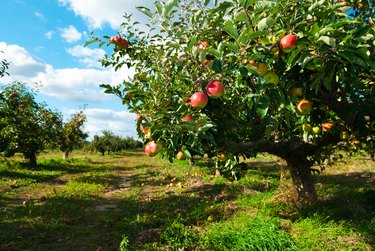
Cultivated apple trees (Malus domestica) originated in Asia Minor, occurring throughout southwestern Russia, Pakistan, western China and northeastern India. Through travel and trade, apples gradually moved westward into Europe. They were brought to the United States by European settlers in the 17th century, where they have flourished ever since. They are an adaptable species of fruiting tree; apple tree adaptations and work by plant breeders has resulted in trees that thrive in U.S. Department of Agriculture plant hardiness zones 3 through 10.
General Apple Tree Habitat
Video of the Day
State, province and country aside, apple trees grow best with full sun, in soil that is deep, moist and well-drained. Loamy soil—soil made of roughly equal parts sand, silt, clay and organic matter—is ideal for cultivating apple trees. Apple trees are extremely cold-hardy and bloom later than many other fruiting trees. They prefer a temperate climate, allowing for winter dormancy, a period of time when growth and development stop. They grow most productively in northern zones, within a latitudinal range of 35 to 50 degrees.
Video of the Day
Apple Trees in the Wild
Naturalized apple trees may be found along forest edges, in disused or abandoned fields, in shrubby areas and former clearings as well as around old homes and homesteads. You may also find the apple's close relative, the crabapple (Malus sylvestris) growing wild in the same habitats in USDA zones 4 through 8.
Because apples and crabapples grow best in full sun, they will fruit less and lose their vitality as other trees grow up around them. This is a result of too much shade and of root crowding. Apple trees also tend to crowd within their own crowns by growing too many branches for the amount of available sunlight and space. Apple trees growing in the wild often produce less fruit as a result.
Apple Tree Orchards
When planting your own orchard, consider that apple trees grow best on slopes, where cold air can sink and warm air can rise. Many apple orchards are planted this way. When there is still danger of frost in the spring, the flowers and buds of slope-growing trees will be at less risk of damage, because the coldest air will slide downhill. Orchard rows tend to be oriented north to south so that they are exposed to sunshine all day.
Apple Trees in the Garden
If you are planting in your yard, the most important things to keep in mind are the basics: sun and well-drained, rich soil. You may want to test your soil so that you have a better sense of which kinds of fertilizer and organic matter (sawdust, manure, mulch, grass clippings and compost) will improve the texture and nutrient value of your soil.
When transplanting bare-root or potted apple trees, take time to dig a deeper, wider hole than necessary for the tree's roots. Loosening the soil up to three times the diameter of the root ball allows the tree's roots to expand into the soil and become firmly established in the garden. In general, avoid amending the soil before backfilling. Instead, add a layer of compost or mulch over the bare soil so the nutrients will slowly leach into the ground over the root ball.
Care of Apple Trees
There are several ways to encourage flourishing apple trees. If you are planting your own trees, this involves good site selection, soil preparation and seasonal pruning. If you are restoring and harvesting fruit from wild trees, "releasing" them will encourage greater yields of fruit. Releasing an apple tree involves removing any trees or shrubs growing next to or below the apple tree that may be restricting its sunshine over the course of the day.
Also sterilize your cutting tools and prune the tree when dormant to remove crowded, crossing and broken branches. Adding air circulation through the branches improves the tree's health and discourages fungal diseases. Thinning the fruits when they are the size of walnuts also gives the remaining fruits room to grow.
- University of Maine Cooperative Extension: Bulletin #7126, Wild Apple Trees for Wildlife
- University of Wisconsin-La Crosse: Malus Domestica BIO 203
- University of Minnesota Extension: Growing Apples in the Home Garden
- North Carolina Extension Gardener Plant Toolbox: Malus Sylvestris
- "Pick Your Own" Orchard and Farm Finder